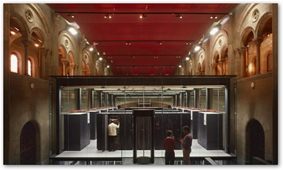Yes, the processes and information needed to sequence and hold your DNA does not fit in an Excel spreadsheet, now the interpretation into  layman's’ terms so you understand could be, but not all the data that is needed to compile this. As we are now able to mine and analyze more than 3% of the available data, up go the storage and power needs, and we are talking even bigger than terabytes. This Research campus is building on to handle molecular studies.
layman's’ terms so you understand could be, but not all the data that is needed to compile this. As we are now able to mine and analyze more than 3% of the available data, up go the storage and power needs, and we are talking even bigger than terabytes. This Research campus is building on to handle molecular studies.
Big Pharma Exploring and Moving Data to the Cloud – IT Execs Talk about How It is Being Done
This is one of the reasons too that the Cloud is interesting many in research as you can use an existing power supply on the internet, close out and be done. There’s a lot of power out there to borrow for some studies. If you read the link below there are some very interesting facts on how big pharma is harnessing the cloud and the “huge” savings they realize. The only downside is to make sure perhaps some additional security considerations are in place, again depending on how and where the cloud use is structured. The picture at the left shows one of the prettiest data centers and you can click on the picture to visit the site to learn more. They are not cheap to build and maintain and why many are considering renting a cloud.
Verizon and Intuit will rent space on the cloud too. BD
Verizon and Intuit Introducing New Cloud Services
Scientific research under way at the N.C. Research Campus generates so much biological information that no spreadsheet or computer file can contain it.
When scientists study biology at a molecular level, as they do in Kannapolis, they encounter problems so complex that a vast and relatively new scientific field is required to help find answers.
It's called bioinformatics, and the University of North Carolina at Charlotte specializes in it.
Bioinformatics can help determine the exact point at which a new cancer drug should interact with a cell.
"Bioinformatics really began as a solution to a problem," said Dr. Lawrence Mays, director for the UNC-Charlotte Bioinformatics Research Center. "The problem was a flood of data that was difficult to understand."
Two decades later, the flood waters continue to rise. A genome that once took years to sequence now takes only weeks, thanks to high-throughput equipment like that at the Research Campus.
Instead of studying one gene at a time, scientists now can use gene chips for gene expression analysis.
"A single chip with an active site the size of your fingernail can be the equivalent of a couple million test tubes," Mays said.
These mind-boggling amounts of data led to bioinformatics, or the discovery, development and application of new computational technologies to help solve biological problems.
"It's forced people to think in a different way," Mays said.
SalisburyPost.com - Area - Researchers at NCRC using bioinformatics




0 comments :
Post a Comment